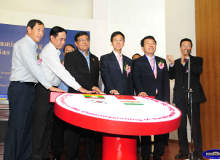
Shwe natural gas project is a multi-field integrated development, consisting of the Shwe, Shwe Phyu and Mya offshore gas fields located offshore Rakhine State in blocks A-1 and A-3 of the Bay of Bengal, Myanmar.
The project is being developed in a three-phase scheme by a consortium of six companies, led by POSCO subsidiary Daewoo International. The consortium includes POSCO Daewoo International (51%, operator), Oil and Natural Gas Corporation (ONGC) Videsh (17%), Myanmar Oil and Gas Enterprise (MOGE: 15%), Gas Authority of India (GAIL: 8.5%), and Korean Gas Corporation (KOGAS: 8.5%).
The first gas production from phase one of the Shwe natural gas project was achieved in July 2013. Phase two and three are currently under development. First gas from phase two of the project is expected in the second quarter of 2022.
The gas produced from the project is being distributed locally in Myanmar, as well as sold to China by China National United Oil Corporation (CNUOC) through a 40in diameter pipeline at the rate of four million cubic feet per day.
Shwe natural gas project controversies and concerns
The Shwe natural gas project faced a lot of criticism, with its environmental impact assessment (EIA) not released prior to the start of construction. It was also criticised for not allocating sufficient gas for domestic use in Myanmar.
Critics alleged that the project’s pipelines pass through ecologically sensitive and residential areas, including rainforests, parks, rivers, marines and sanctuaries.
Human rights activists opposed the Burmese military’s acquisition of land in the Gown Chewin, Thit Pate Taung, and Saba Shar areas to make way for the pipelines without providing compensation for the local population.
Fishing was banned in the area by the Burmese Navy, affecting the livelihood of local fishermen.
Shwe natural gas project reserves
The combined natural gas reserves of the three gas fields are estimated at 4.53 trillion cubic feet. The Shwe gas field, discovered in 2004, has the largest gas reserves among the three fields.
Shwe natural gas project phase one development details
Phase one of the project involved drilling four subsea production wells and tying them back to an integrated drilling and processing platform. Infrastructure includes an offshore platform, submarine pipelines, an onshore gas terminal and a supply base jetty facility at Kyauk Phyu, Myanmar.
The 40,000t offshore platform, located at a water depth of 110m, processes and transports gas to the onshore facilities. It features drilling facilities and gas restoring systems.
The platform jacket and the topside, with distributed systems foundation (DSF), weigh 22,000t and 30,000t respectively. They were assembled in November 2012.
Phase two project details
The second phase of the project includes the installation of subsea umbilical risers and flowlines (SURF) and a subsea production system (SPS) for connecting eight subsea wells at the water depth between 85m and 142m to the processing platform.
The SPS includes eight medium-water horizontal Xmas trees, eight production control systems, topside control systems and distribution equipment.
McDermott’s state-of-the-art pipe laying vessel, including the Derrick Lay Vessel 2000, will be used for carrying out the subsea operations.
Phase three of the project includes designing a new compression platform, the modification of the existing platform and the construction of a bridge linking the platforms.
Pipeline details of Shwe natural gas project
The gas pipeline was laid between Kyauk Phyu in Arakan state to Kunming and onto Nanning in China. A 32in diameter export pipeline was laid for a distance of 110km, while a 14in diameter infield pipeline was laid for 12.5km.
Natural gas from the field is piped through infield pipelines to the Shwe platform, where it reaches land at Kyaukphyu via export pipeline and moves to the export terminal on Ramree Island. It is then exported through the 2,800km Myanmar to China gas pipeline network.
Contractors involved
MOGE is the project in charge and manages the planning and execution of the project.
Hyundai Heavy Industries (HHI) was awarded a $1.5bn engineering, procurement, construction, installation and commissioning (EPCIC) contract to construct the underwater jacket and the top side of the platform in February 2010. It also included the construction of other support facilities.
Dockwise Engineering Services was subcontracted by HHI for the platform transportation and installation. Doris Group was subcontracted for providing the project’s engineering, project management and coordination services.
HHI used Bentley’s MOSES and SACS models and CNOOC Engineering’s bottle-shaped barge HYSY 229 for transporting the platform to the project site.
JDR Cable Systems provided a 13,650m-long production control umbilical cable, while Dietswell provided FEED services. POSH vessels were used for the transportation and installation of the jackets.
Trelleborg provided floatover mating technology for the Shwe platform as part of a contract signed in December 2013. The company also supplied leg mating deck support units, load transfer units and floatover fender systems.
KCA Deutag will provide operation and maintenance drilling services for the platform under a two-year contract awarded in June 2013.
A consortium of McDermott and BHGE received a subsea contract for the second development phase of the project in June 2018. McDermott also received the front-end engineering design (FEED) contract for the development in September 2019.







